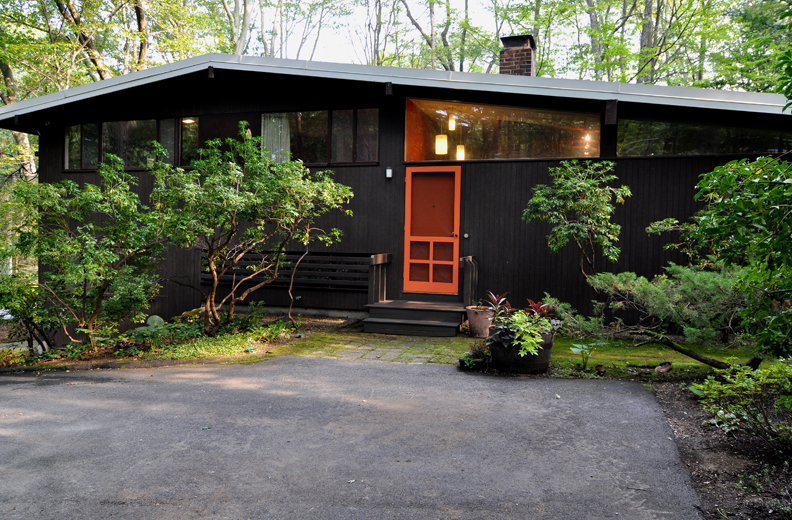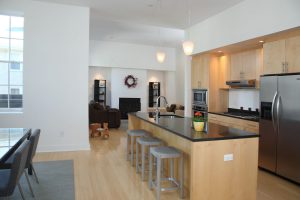
Click any photo to enlarge:
[slideshow caption=”on”]
SOLD January, 2012 $622,000. One of the first Peacock-Farm style houses built outside of the Peacock Farm development, this 1958-built modernist home was designed by Walter Pierce and updated by the current owners, an architect and a designer/artist, only the second set of owners of this particular example of the coveted style, offered at $634,000.
The layout is a classic one here in Lexington. Upon entering the front door, one is taken into an informal foyer created by the brick of the rear of of the fireplace and an interior wall. The house opens up dramatically upon turning right, with ceilings that vault upward with the chimney in the living room, and downward to the end of the house, drawing one’s eye toward the large window overlooking the patio, also creating a more intimate dining space. The current owners have opened up the wall between the dining room and kitchen, creating more of a loft feel. Most (I only hesitate to write “all”) of the interior walls in Peacock Farm-style homes can be changed, as the construction is post and beam, the former jettisoning the need for load-bearing interior walls.
If one were to look to the left upon entering, instead of heading right as described above, (s)he sees the split stairway, a few steps leading up to three bedrooms and a bath, or down, to a family room with separate exterior entrance/egress, a study (potential fourth bedroom), a second full bath, and the utility room. Additional storage is in a crawl space through the utility room.
The original home has been lovingly maintained throughout both sets of owners. The current sellers added their own updates, including:
- New chef’s kitchen in 2010, with new cabinets; Caesarstone counters; Viking dual-fuel gas range (propane) with electric oven; Viking built-in refrigerator; Thermador dishwasher; cork flooring; newly painted walls; and new lighting
- New full bath, gutted and renovated from the studs, with separate soaking tub; glass-door walk-in tiled shower stall with inset shelf; vanity with solid black granite; towel warmer-radiator; separate entrance for hall and master bedroom
- New electrical service in 2007
Some of the later improvements from the original owners(*) include:
- 2006 boiler installed by Arlex Oil
- 2003 sanding and refinishing hardwood floors
- 2002 re-paved driveway
- 1999 shed
- 1993 new roof and insulation
- Full list kept by previous owner can be furnished as a .pdf, upon request. (*Please note that neither the current owner nor their agents can attest to its accuracy).
The house sits on a 30,430 s.f. private lot and has a deeded swimming pool membership.
Showings to begin Friday, September 9, with public open houses Saturday and Sunday, 9/10 & 9/11. Contact Bill and John for private showings or if you have any questions.
Turning Mill Neighborhood
Most people in Lexington know the area as Turning Mill, but it started out being referred to as Middle Ridge. Though it is now a large area of eight or nine streets, it started around Demar Road, with Techbuilt houses designed by Carl Koch, before growing further north and west and incorporating other modern designs, most notably, the Peacock Farm-style house plan designed by Walter Pierce, who along with Danforth Compton founded Lexington’s Peacock Farm neighborhood on the other side of town. This design was licensed out to other developers, as was the case here in Turning Mill. There have also been some Deck Houses built. The expanded part of the area is now referred to as “Upper Turning Mill.”
Residents love the area due to its proximity to Estabrook Elementary school (adjacent) and because it offers membership in the country-club-like Paint Rock swimming pool. It also borders the vast Paint Mine conservation area, with beautiful walking trails. The Lexpress bus runs through. And a quick zip takes you down backroads to Whole Foods, Staples, Super Stop & Shop, Marshall’s, and so on in Bedford, or back the other way into the center of Lexington. And it is not far from Route 128.
Here is the swimming pool from this past summer:
The “Peacock Farm” style and the history of mid-century modernist homes in and around Lexington, from our web site, Modernmass.com. Also see our video tour.
One of three important planned modernist developments, “Peacock Farm” was just a stone’s throw across Pleasant Street from the swimming pool of Six Moon Hill. This community was founded not by an architect associated with Harvard, as TAC was, but by Walter Pierce, from Harvard’s Cambridge rival, MIT. As Laurie Atwater began her article in Lexington’s Colonial Times newspaper,
*The cover of the Sunday edition of the New York Times for September 13, 1959 announced: Russians Fire Rocket to the Moon, Expected to Hit Target Today….
Inside the pages, a story from Lexington, Massachusetts: Colony of Contemporary Homes Will Be Repeated Near Boston.*
Pierce started his own architecture firm with Danforth Compton after studying at MIT with (amongst others) Carl Koch, a former student of Walter Gropius and a founding father of modern prefab housing in America as the founder of Techbuilt and Acorn Homes. Compton and Pierce noticed a “for sale” sign off of Route 2, Peacock Farm Road, a turn off of Watertown Street in Lexington. There was a 45-acre farm filled with wetlands, ledge, and woods. The two architects set out to become the developers of the site, with a plan they referred to as the “Program.” The concept was to build modern, aesthetically progressive homes that would be from a stock design yet looked as if they were custom built for the land.
After initially designing one-floor houses and building a handful of them, Compton suddenly and unexpectedly passed away and Pierce went on to design what is now known as the Peacock Farm House, a modern split-level home that, as Atwater notes in her article, “allowed the home to be ‘of the hill,’ as Frank Lloyd Wright” espoused. The shape of this house style was flexible enough that it could adapt to flat or sloping lots. With some subtle variations, the typical Peacock Farm House had an entrance in the center of the broad side of the structure, a few steps up to a second floor consisting of three bedrooms and a bath or a bath and a half. There is the main floor with a kitchen, dining area and living room with a fireplace and exposed brick chimney. The structure was a basic post-and-beam system with few if any interior load-bearing walls, allowing for great flexibility in the floor plans, and many large windows unobstructed by sashes, mullions, or any unnecessary architectural features. A few steps to a lower level set in various depths of the grading of the site and sometimes a second lower level basement, depending on how much of a slope was present.
The Compton-Pierce team challenged the traditional notion of a house needing to be facing more or less square to the street. Free from this principal, they oriented the homes to be complimentary to the sites, taking advantage of the views and offering the sites the appearance of more space in between the houses. This was also counter to the trends of most modern developments, which seemed to operate from a scorched earth policy, clearing the land and plopping down cookie-cutter houses one after another and then possibly going back to plant saplings after the fact.
Many of these homes have been renovated and expanded over the years, much like those on Moon Hill and Five Fields. They are very adaptable to such modifications. The simple approach demonstrated by these forward-looking architects of the mid-century was mostly that of rationality, using one or two plans and adapting them to the contours of the existing land with as little disturbance as possible to the existing conditions of the environment. Though these houses were not, as originally built, the most energy efficient by today’s standards, due to outdated heating systems, relatively little insulation, and large single-paned windows, they are easily retrofitted with updates for all of those components. They were, however, “green” from the get-go in their approach to land use, both in the conserving of the existing flora, with few having traditional lawns even today, minimizing impermeable surfaces (gravel driveways, e.g.), and reasonable lot sizes with larger amounts of common land for all to enjoy.
Which brings us to the socio-political philosophy that underlies these communities’ origins. Not only were these houses extraordinarily “new” in their styles, standing in stark contrast to the traditional New England vernacular via a contemporary European artistic aesthetic, but the founders of these developments also brought an egalitarian approach with attention to developing a community ideal that contrasted the largely politically and socially conservative post-war suburbs. Levittown was about conforming to the new neat and largely homogeneous suburban idea of the American Dream, trimmed lawns hemmed in by squared fences. These Lexington modernist developments tended to encourage responsibility and cooperation in the neighborhood as a whole, with partnerships in the non-profit corporations formed to watch over the common areas and the upholding of the benign covenants.


